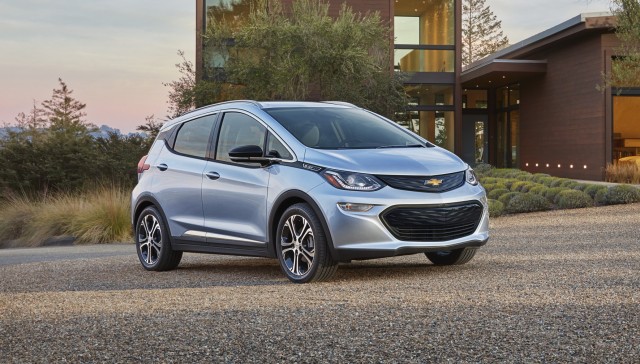Tesla Model 3 preorder frenzy should have Chevy Bolt green with envy
ANALYSIS:
More than 325,000 potential buyers have put down $ 1,000 apiece for a Tesla Model 3 electric car that they won’t get for two years, if not considerably longer than that.
Which must frustrate the electrification team at General Motors deeply.
The 2017 Chevrolet Bolt EV with more than 200 miles of range and a starting price of $ 37,500 is already in pre-production, and could go on sale late this year—fully a year before Tesla’s announced delivery date for the Model 3.
Two recent articles from Detroit news outlets convey different reactions to this disparity.
“If you are an executive at a venerable automaker whose company is working on the same technology,” writes reporter Richard Truett in industry trade journal Automotive News, “seeing crowds waiting in line to lay down a deposit for a Model 3 had to have been tough to watch.”
The piece goes on to compare the crowd eagerness for Tesla not to anything else in the auto industry, but the enthusiasm for the latest consumer electronic devices from Apple.
Buyers waiting to reserve Model 3 electric car, Tesla Store, Santa Barbara, CA [photo: David Noland]
Remember those lines for the first iPhone, or the first iPad?
Same thing, suggests Truett—who calls himself “an Apple devotee”—ending his piece this way: “If Tesla is the automotive equivalent of Apple, the industry will be forever changed.”
But why aren’t the crowds just as eager for the Bolt EV, you might ask?
One answer is that they could well be, but General Motors didn’t choose to crowd-source its development funding and reap the associated marketing benefits of such high numbers.
But another is that GM itself can’t take deposits for the car. It’s not legally allowed to sell you a Chevy Bolt EV.
Instead, you must purchase the car from an independently-owned third party known as a car dealer, under state franchise laws, after haggling for the vehicle.
Tesla Store Los Angeles [photo: Misha Bruk / MBH Architects]
Both GM and Tesla have many hurdles to cross before electric cars become a sustainable, profitable, and preferred choice for significant volumes of car buyers.
But if buyers are viewing an electric car more like a very expensive piece of consumer electronics, and willing to put down $ 1,000 for two or more years to get in line for one, the auto-industry standard practices that prevent GM from acting more like Tesla may be seen as confounding and inexplicable.
Savvy industry observer and commentator Daniel Howes explores this “double standard” in comparing the Bolt EV to the Model 3 in a Detroit News opinion piece this morning.
“The disruption of Detroit has a name,” he opens, “and it’s Tesla Motors Inc.”
Howes goes on to note that he asked a ranking GM executive about the two companies and disparity in their public receptions. (The executive chose to stay anonymous.)
President Barack Obama looks at 2017 Chevrolet Bolt EV electric car at Detroit Auto Show, Jan 2016
“He sighed, mumbled something about Tesla being a tech company dabbling in autos instead of an auto company dabbling in tech,” Howes writes, “and added that there’s ‘no justifiable reason’ for Tesla’s valuation.
Then comes the punchline:
Musk gets the benefit of the doubt from investors, customers, even a skeptical media.
GM? Not so much, which should be not at all surprising given its long history of mediocrity, of false promises, of playing a more conservative game than it talks.
In other words, Tesla gets the benefit of the doubt for the desirable cars it’s launched and the remarkable things it’s done (Supercharger network, cough) in a very short time.
GM is still atoning for past sins of product design, sins of assembly quality, sins of financial mismanagement and lack of board oversight, and many more.
2017 Chevrolet Bolt EV
The auto-industry truism in the end is that it’s all about the product.
Which should make the Bolt EV versus Tesla Model 3 battle a fascinating one indeed. (And then there’s the next Nissan Leaf too.)
Lay in some popcorn, folks. This promises to be fun to watch.
This post first appeared on Green Car Reports.





![Buyers waiting to reserve Model 3 electric car, Tesla Store, Santa Barbara, CA [photo: David Noland] Buyers waiting to reserve Model 3 electric car, Tesla Store, Santa Barbara, CA [photo: David Noland]](http://images.hgmsites.net/med/buyers-waiting-to-reserve-model-3-electric-car-tesla-store-santa-barbara-ca-photo-david-noland_100551115_m.jpg)
![Tesla Store Los Angeles [photo: Misha Bruk / MBH Architects] Tesla Store Los Angeles [photo: Misha Bruk / MBH Architects]](http://images.hgmsites.net/med/tesla-store-los-angeles-photo-misha-bruk-mbh-architects_100449435_m.jpg)








Comments are closed.